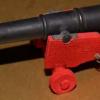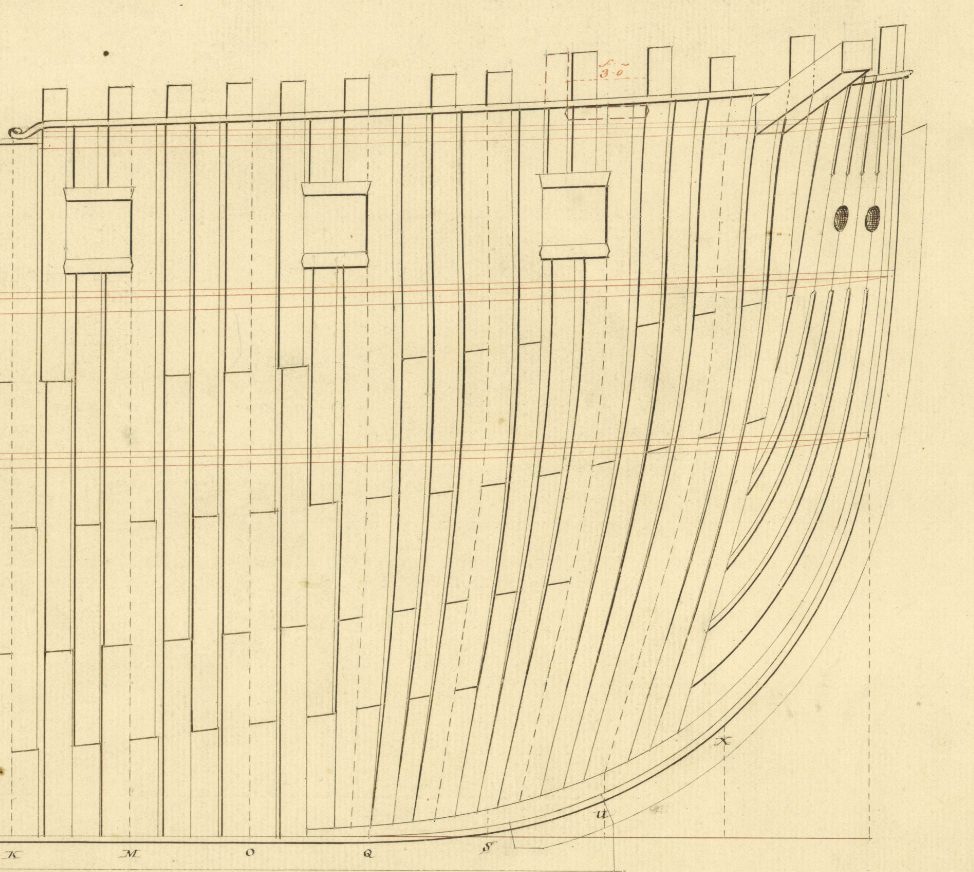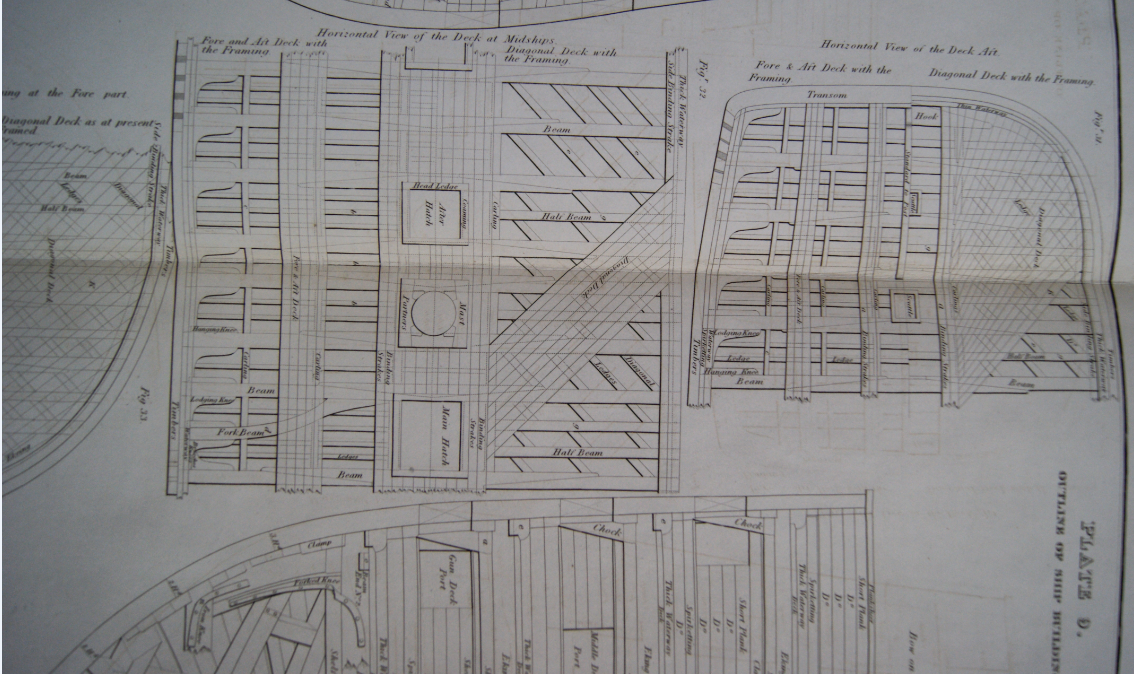-
Posts
1,761 -
Joined
-
Last visited
Content Type
Profiles
Forums
Gallery
Events
Everything posted by Mark P
-
For any who might be interested, I posted a review of Richard Endsor's most recent book, 'The Master Shipwright's Secrets', in the books section; and also on Amazon. It is a very well-researched and most informative work, with some wonderful fold-out plates by the author, who is an accomplished artist. All the best, Mark
-
Good Evening Allan; 1715 it was; surprisingly, although saving timber was one reason for adopting this measure, the main consideration seems to have been to prevent decay, which was more prevalent in these areas. Perhaps because a square frame with a large bevel results in a much longer mating surface between the frame and the planking, thereby trapping more moisture than would a canted frame with its shorter mating surface. All the best, Mark
-
Good Morning Druxey; I don't possess as many disposition of frame drawings as I would wish, most regrettably, mostly dating from the 1780s. On the majority of these, while the joints in the lower futtocks are indicated by a single line, the uppermost joints, to the shorter top-timbers, are indicated by two lines, the correct distance apart for a scarph, with the lower line frequently dashed. This difference in treatment can only indicate a scarph joint as opposed to a chocked joint. The earliest of those which show this is Bombay Castle, dated Navy Office 1779. On only one frame plan are Xs drawn between these two lines, though, which would indicate to me that an X was not always shown. This has also been described in writing, but I cannot recall if this was in a modern or contemporary work. It would certainly be interesting to know how far back this method extended. All the best, Mark P
-

Rigging Confusions - Lifts, Halyards and More, Oh My!
Mark P replied to rraisley's topic in Masting, rigging and sails
Good Evening RR; I think that the best solution to your dilemma is to try and purchase copy of James Lees' book 'The Masting and Rigging of English Ships of War, 1625-1860. This describes the rigging of a variety of ship types through a long period, and goes into all the sort of detail which will answer your questions, and all the others which you haven't yet asked as well! Copies can normally be found on Amazon, or try Bookfinder, which currently has them starting at £35, up to the best part of £200. If you are in the US, they are also available there. All the best, Mark P -
Good Evening Don; To expand upon Allan's quite correct explanation, the dashed line shown in the framing plan in my earlier post is the profile of the station line of the double cant timber, when viewed from a point square to the keel. It does not represent any line shown on the body plan, and is obtained by extrapolating from the cant timber lines as drawn on the half-breadth plan. The dashed lines of the cant stations are never shown on the main draught of the vessel, and only appear on the framing plan. All the best, Mark
-
Good Evening Druxey; You are quite correct about the rationale behind the use of chocks, they do enable the use of shorter or less curved timber. However, by reason of the top-timbers having little curve, and, especially towards the stern, being almost straight, the use of chocks conferred little advantage from the point of saving timber, and actually involved more work, in that cutting chocks and their mating joints involves four angled cuts, whereas a scarph involves cutting only two. John Fincham, who was headmaster of the Naval Academy at Portsmouth, illustrates this very clearly in the plates which accompany one of his books (can't remember which, unfortunately!) His plate shows the practice in the time shortly before Seppings' reforms introduced the dowelling together of futtocks, but is certainly applicable to much earlier decades, for the reasons outlined above. I have also seen earlier illustrations showing the same thing, and have seen it in written descriptions. All the best, Mark P
-
Good Morning Lieste; You are quite right regarding Steel; however, that is a good example of why his authority cannot necessarily be extrapolated backwards in time. The method he uses was introduced in 1794, I believe. Prior to that, the mast length was either based on calculations using the beam, or the keel and beam. In the 17th century, keel, beam and depth were used in the calculations. All the best, Mark P
- 19 replies
-
- running rigging
- standing rigging
- (and 1 more)
-
Good Evening Marcus; To follow on from Bob's post above, the United Provinces, as the Netherlands was then known, were probably the worst offenders in the variable foot field. Each of the administrative districts had its own foot. Must have been a bit of a nightmare for journeyman shipwrights. Regarding the rigging, the essential point is that it was done by rule of thumb, and in most countries everything started off with the length of the mainmast, with everything else based on a particular fraction of its length. The divisor applied varied from country to country and from period to period, but knowing the mast length meant that those with the correct knowledge could calculate the diameter of all other ropes. The length of the mast was, in Britain at least, based on calculations using the length of the keel and the ship's beam. On the subject of Cook and Australia, it was indeed known that there was something in the area; I have seen a French map dating from around 1715, which showed a line south of the main East Indies, marked as some kind of unknown land. But Cook was the first to prove its size and survey so much of its coastline. All the best, Mark P
- 19 replies
-
- running rigging
- standing rigging
- (and 1 more)
-
Good Evening Don; In the English Navy, cant timbers continued the pattern of the main frames, in that (for example) two filling frames were followed by a double frame (I hesitate to call a double cant timber a 'bend') The pattern of scarph joints was continued from the square frames, except in the lowest timbers, which no longer had to straddle the keel, so the lowest scarphs were no longer needed. The uppermost joint was normally a plain scarph joint, without a chock, as with the square top-timbers. The longest futtocks of the double cants were called 'half-timbers'. This may also have applied to those of the filling frames, but my memory not powerful enough to recall this for sure (need a few more MB inserting) See below an excerpt from a framing plan which shows the bows of Andromeda of 1784 The dashed line is the station line of the cant, centred on the joining faces of the double frame. Note that the station line location, as drawn at the keel, did NOT give the position of the station line at the keel, but at the height of maximum breadth. For example, in the clip below, the 'S' near the boxing is not below the bottom end of the dashed line, but is vertically below the line of station 'S' at the foremost point, which is the maximum breadth (note that this does not work any longer as the maximum breadth becomes, in theory at least, the flared out part of the top-timbers) All the best, Mark P
-
Good Evening Gentlemen; Not sure if anyone is still looking for this, but there are various copies advertised on the 'Bookfinder' website. The below version is not cheap, but there are others. I picked up a decent copy through that same website a while ago, for much less. The shipbuilding manuscript is also for sale on the same site. All the best, Mark P
-
Good Morning Gentlemen; an interesting topic; I have checked my photos of ship models, and all the 74s, which are Ajax, Egmont, & Warrior, have backstay deadeyes on both fore and main masts, either as a narrower extension on the aft end of the channels, or as a separate stool; but no stool or deadeyes on the mizen channels. I also have pictures of the Thunderer/Hercules (which I strongly believe is actually Hero) which does have mizen backstays on a stool, but this was rigged in the NMM in the later 20th century, and these just might have been added then. Although looking at the as-built draughts, which again all show backstays for the fore and main masts, Ramillies, 1785; and Warrior do show a separate backstay stool for the mizen. Yet the draughts for Alfred and Cumberland do not show a mizen backstay stool. It is perhaps possible that the mizen backstays in some ships were set up with a lanyard to an eye-bolt in the topsides outboard. However, it is interesting that the model of Warrior shows her without backstay deadeyes, yet the as-built draught does show them. Draw your own conclusions! All the best, Mark P
-
Good Evening Allan/Roger; I can confirm that none of the contracts held at either the NA or at the NMM have been digitised. The NMM ones are available as copies, but the last I heard this was an expensive service. At the NA, search under ref ADM 106/3071. This will bring up what looks like a bunch of contracts dealing with sick and wounded, but is actually largely comprised of ship contracts. Amongst these are several for 10 gun ketches of 1690-94. However, the index entry online is brief, and does not list the documents individually. There are a couple of earlier contracts for ketches from 1664 in the State Papers, but these are not generally available, as they are restricted access documents; obtaining copies of these would perhaps be possible via the NA's copying service. However, they are very brief, and do not give a lot of detail of the structure; unlike the ADM ones, which are several pages long. All the best, Mark P
-

National differences in rigging?
Mark P replied to Smile-n-Nod's topic in Masting, rigging and sails
Good Afternoon Brett; If you really seriously want to know the differences, and your interest lies in the 18th century, I recommend that you obtain a copy of 18th century rigs & rigging, by Karl-Heinz Marquardt. This gives in great detail the rigging of ships of many nations. All the best, Mark P -

17th century English merchant flags
Mark P replied to Louie da fly's topic in Nautical/Naval History
Good Evening Stephen; Druxey is correct, but they flew the St George's cross also. Timothy Wilson's very useful book 'Flags at sea' gives the following for merchant ships, set down by a royal proclamation in 1674: 'The Flag and Jack White, with a Red Cross (commonly called the Saint George's Cross) passing quite through the same [that is, filling the whole flag, not in the canton] And the Ensign Red, with the like Cross in a Canton White, at the upper corner thereof next the staff'. English merchant vessels were banned from using the Union flag as flown on the King's ships from 1606. However, it would appear that many vessels ignored this ban, as it brought exemptions from various duties and requirements in some foreign ports, and helped to prevent having crews pressed; as well as, presumably, helping to discourage pirates from attacking what might be taken as a warship from a distance. That the ban was widely ignored is illustrated by various attempts to stamp out the practice, including by Samuel Pepys; seemingly without much success, as such attempts and various proclamations prohibiting it, continued into the 18th century. Various official trading organisations, such as the East India Company, also flew their own flag. all the best, Mark -
Good Evening Everyone; Gunwale is the timber otherwise known as the plansheer, or planksheer, which was fitted to the top of the timbers of the main frame, and capped them off. I have not seen cap-rail referred to in any Royal Navy documents, although it is certainly performing a capping function, and may well have been so called in other times or places. When gunpowder weapons were first introduced on board ships, it seems that they were mounted on the top of the ship's side, presumably somewhat like swivel guns, in a metal fork. So the name of the strengthening wale which ran along the top of the waist (and which may well have been called the cap-rail) was presumably changed to gunwale reflect this new use. An important point in the naming of this as the plansheer is that the curved line of the tops of the timbers in the waist, as seen on the sheer plan, is continued along the ship, running right to the stern and bow, and becomes a largely theoretical line which is used to shape the plan of the ship's upperworks at her narrowest point, as shown on the draught, although this is not actually her narrowest point once fore or aft of the hancings, and is only true in the waist. All the best, Mark P
-
Good Evening Amalio; I agree with Druxey; that is a very clever way of making the same shape of baluster. Thanks for sharing it with us. A beautifully constructed model. All the best, Mark P
-
Good Morning Dave; As you are dealing with the lifts, the item at 'F' will almost certainly be a hook which is put into an eyebolt set in the side of the mast cap. However, in some rigging setups, the lifts also function as topgallant sheets; a resemblance which you noticed. More research needed! All the best, Mark P
-
Good Morning Frolick; If that was just a humourous reaction to the possible double meaning, then ignore the following, but: Just to be sure, and in case this expression is not used in the States, it means to step delicately around something, verbally, which the speaker/writer does not want to mention directly. It can also be used to describe various situations where someone is not exerting themselves hard enough to achieve success. All the best, Mark P
-
Good Evening Everyone; The word which everyone seems to be pussy-footing around so carefully is so old that its origins and early use are hard to trace, with similar words in a variety of languages. However, in medieval times it was a perfectly acceptable word, and did not have the shock-power that can now be attributed to it in some contexts. Sailors, not unnaturally, adopted it to describe something which was as close to the girl back home as they could get whilst at sea (cabin boys excepted, if they were so inclined, of course) And so 'see-you-enn-tee' -splice became an inoffensive and widespread description. I have also seen the word used to describe the place in a tree where the trunk forks into two branches, which usage would doubtless have been familiar to shipwrights selecting trees for felling. In Regency and Georgian times the word is also widespread, and not necessarily shocking, being used in satirical prints as a simple descriptor, along with its more common four letter sibling. Victorian ladies reaching for the smelling salts upon hearing a word which could be sexual in its meaning changed the accepted conditions for using the word, I suspect. So three cheers for sailors and their vocabulary. It's a see-you-enn-tee-splice, so let's call it that! All the best, Mark P Edit: I wrote the proper word, but the site's software has asterisked it out. So I will try a small change.
-
Good Evening George; Thanks for the explanation. Ditto I am familiar with, of course, but I thought that this must be connected with the following words and did not think of ditto. 'Wr' I now remember from other logs long ago, but had forgotten, so glad to have that knocked into my consciousness for future reference. I really enjoy reading old MSS; there is so much to discover. Re Caruana, I managed to track down a copy in Japan, and got it for $250. Very useful book, as Druxey says. On the other hand, when Caruana first published one of his volumes (I think it was vol II) it was reviewed in Model Shipwright, I believe by Robert Gardiner. He was not impressed, and gave it a very negative writeup, listing many errors and oversights. Quite an eye-opener it was. Trouble is, there is no other work to compare with it; at least, not as far as I am aware; and it does contain a lot of useful information. All the best, Mark
-
Good Evening George; The note from the log reads as follows, as best as I can make it out (abbreviations can be difficult to read when dealing with only a small part of a document, so I am not clear on the beginning and a few other bits) Wednesday 7th Notes ?? sent 2 long six pounders ? 12 p? Carronades. shot &c ??? Mr? (Master? Could also be Wm for William but that does not fit context) Shipwrights employed on board. Crew variously received 88 Gall of Beer.
-
This is an absolutely wonderful model! The weathered look of the sails is a great touch, but is only to be expected from such a careful, thoughtful, and incredibly skilled builder. Every little detail of this whole model bears witness to your dedication to producing a truly outstanding contribution to the field of ship modelling. Your methods for building in your chosen material are revelatory, and are, I am sure, an example which has brought the versatility of card to the notice of many who had no idea that such results were possible; and the same with your method of producing the decorative works. I join in with so many others who can only praise your works. Many, many congratulations!! Simply beyond words, really!! All the best, Mark P
- 1,035 replies
-
- royal katherine
- ship of the line
-
(and 1 more)
Tagged with:
-
Good Morning Everyone; I can understand the reason for making the lower planking diagonal in a model for strength, if this layer is then covered by a more normally-oriented set of planking. Re full size practice, when Robert Seppings became Surveyor of the Navy in the early 1800s, one of the reforms which he introduced was diagonal deck planking, and diagonal riders. The riders were successful, but the deck planking was dropped after a few years, if I remember correctly. See below part of a plate from John Fincham's works, showing some ways in which this was done. Diagonal ledges seems to run counter to one of his guiding principles though, which were to reduce timber consumption, as well as to add strength. All the best, Mark P
About us
Modelshipworld - Advancing Ship Modeling through Research
SSL Secured
Your security is important for us so this Website is SSL-Secured
NRG Mailing Address
Nautical Research Guild
237 South Lincoln Street
Westmont IL, 60559-1917
Model Ship World ® and the MSW logo are Registered Trademarks, and belong to the Nautical Research Guild (United States Patent and Trademark Office: No. 6,929,264 & No. 6,929,274, registered Dec. 20, 2022)
Helpful Links
About the NRG
If you enjoy building ship models that are historically accurate as well as beautiful, then The Nautical Research Guild (NRG) is just right for you.
The Guild is a non-profit educational organization whose mission is to “Advance Ship Modeling Through Research”. We provide support to our members in their efforts to raise the quality of their model ships.
The Nautical Research Guild has published our world-renowned quarterly magazine, The Nautical Research Journal, since 1955. The pages of the Journal are full of articles by accomplished ship modelers who show you how they create those exquisite details on their models, and by maritime historians who show you the correct details to build. The Journal is available in both print and digital editions. Go to the NRG web site (www.thenrg.org) to download a complimentary digital copy of the Journal. The NRG also publishes plan sets, books and compilations of back issues of the Journal and the former Ships in Scale and Model Ship Builder magazines.








